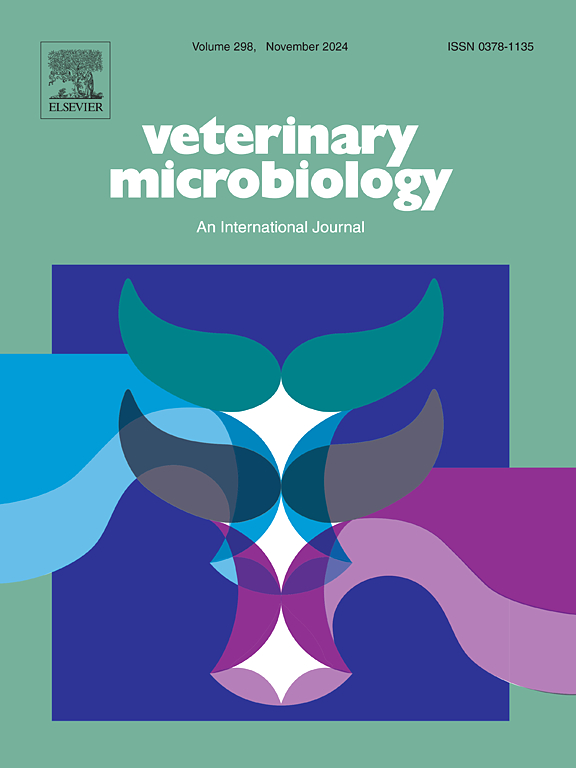hdac - 4通过负调控MEF2A-GLUT1/3轴介导的葡萄糖摄取抑制猪流行性腹泻病毒感染
IF 2.4
2区 农林科学
Q3 MICROBIOLOGY
引用次数: 0
摘要
猪流行性腹泻病毒(PEDV)是一种猪肠道致病性冠状病毒,可引起新生儿仔猪严重腹泻和死亡。组蛋白去乙酰化酶4 (HDAC4)是IIa类去乙酰化酶的一员,控制着广泛的生理过程,但对其在PEDV感染中的作用知之甚少。在这里,我们报告了一种新的策略,通过PEDV操纵HDAC4。首先,检测HDAC4的表达,发现pedv感染的Vero和IPEC-J2细胞中HDAC4表达显著下调。随后,通过特异性小干扰RNA (siRNA)敲低HDAC4导致病毒感染增加,而过表达HDAC4显著抑制PEDV感染。在机制上,我们发现HDAC4显著降低了葡萄糖摄取,因为PEDV感染需要葡萄糖。通过筛选,我们确定了葡萄糖转运蛋白1和3 (GLUT1和GLUT3)在PEDV感染期间负责葡萄糖摄取。我们进一步证实,HDAC4通过其聚集中枢肌细胞增强因子2 A (MEF2A)调节GLUT1和GLUT3的表达。综上所述,这些发现有助于更好地理解HDAC4通过MEF2A-GLUT1/3调节葡萄糖摄取以限制PEDV感染的新功能,并为抗PEDV药物的开发提供新的策略。本文章由计算机程序翻译,如有差异,请以英文原文为准。
HDAC4 suppresses porcine epidemic diarrhea virus infection through negatively regulating MEF2A-GLUT1/3 axis- mediated glucose uptake
Porcine epidemic diarrhea virus (PEDV), a porcine enteropathogenic coronavirus, causes severe diarrhea and death in neonatal piglets. Histone deacetylase 4 (HDAC4), a member of class IIa deacetylases, controls a wide range of physiological processes, but, little is known about its role in PEDV infection. Here, we report a novel strategy by which PEDV manipulates HDAC4. First, HDAC4 expression was examined, and showed a significant down-regulation in PEDV-infected Vero and IPEC-J2 cells. Subsequently, knockdown of HDAC4 by specific small interfering RNA (siRNA) led to an increase in viral infection, whereas overexpression of HDAC4 remarkably suppressed PEDV infection. Mechanistically, we showed that HDAC4 significantly reduced glucose uptake, as glucose is required for PEDV infection. Through screening, we identified glucose transporters 1 and 3 (GLUT1 and GLUT3) as responsible for glucose uptake during PEDV infection. We further confirmed that HDAC4 regulated GLUT1 and GLUT3 expression through its converging hub, myocyte enhancer factor 2 A (MEF2A). Taken together, these findings contribute to a better understanding of a novel function of HDAC4 in regulating glucose uptake via MEF2A-GLUT1/3 to limit PEDV infection, and provide new strategies for the development of anti-PEDV drugs.
求助全文
通过发布文献求助,成功后即可免费获取论文全文。
去求助
来源期刊

Veterinary microbiology
农林科学-兽医学
CiteScore
5.90
自引率
6.10%
发文量
221
审稿时长
52 days
期刊介绍:
Veterinary Microbiology is concerned with microbial (bacterial, fungal, viral) diseases of domesticated vertebrate animals (livestock, companion animals, fur-bearing animals, game, poultry, fish) that supply food, other useful products or companionship. In addition, Microbial diseases of wild animals living in captivity, or as members of the feral fauna will also be considered if the infections are of interest because of their interrelation with humans (zoonoses) and/or domestic animals. Studies of antimicrobial resistance are also included, provided that the results represent a substantial advance in knowledge. Authors are strongly encouraged to read - prior to submission - the Editorials (''Scope or cope'' and ''Scope or cope II'') published previously in the journal. The Editors reserve the right to suggest submission to another journal for those papers which they feel would be more appropriate for consideration by that journal.
Original research papers of high quality and novelty on aspects of control, host response, molecular biology, pathogenesis, prevention, and treatment of microbial diseases of animals are published. Papers dealing primarily with immunology, epidemiology, molecular biology and antiviral or microbial agents will only be considered if they demonstrate a clear impact on a disease. Papers focusing solely on diagnostic techniques (such as another PCR protocol or ELISA) will not be published - focus should be on a microorganism and not on a particular technique. Papers only reporting microbial sequences, transcriptomics data, or proteomics data will not be considered unless the results represent a substantial advance in knowledge.
Drug trial papers will be considered if they have general application or significance. Papers on the identification of microorganisms will also be considered, but detailed taxonomic studies do not fall within the scope of the journal. Case reports will not be published, unless they have general application or contain novel aspects. Papers of geographically limited interest, which repeat what had been established elsewhere will not be considered. The readership of the journal is global.
 求助内容:
求助内容: 应助结果提醒方式:
应助结果提醒方式:


